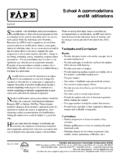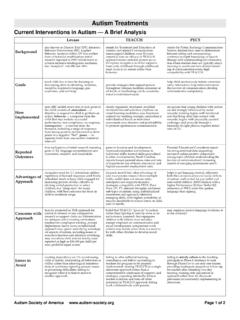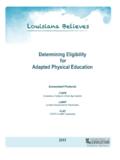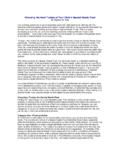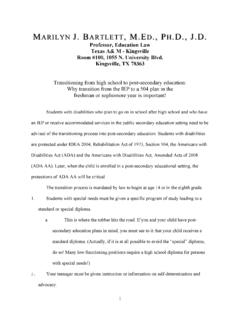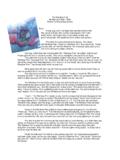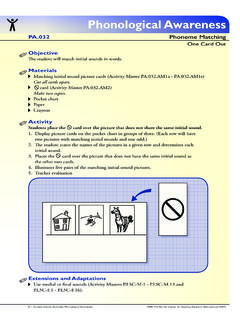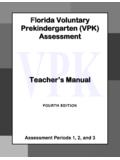Transcription of Scientifically Based Reading Programs - Wrightslaw
1 Scientifically Based Reading ProgramsMarcia L. Kosanovich, center for Reading ResearchSLP AcademyFall, 2005 Goals for the big picture of an effective Reading important characteristics of Reading Programs that are aligned with current about the purpose, content, and process of FCRR how to access FCRR Reports and related opportunities for SLPs to help every child become an independent, fluent skillson which early Reading instruction should focus3 Three types of assessmentto guide instructionScreeningProgress monitoringDiagnosisiiHigh quality initial instructionis criticaliiiImmediate intensive interventionsfor children lagging behind in the growth of critical Reading skills5 + 3 + ii+ iii= NCLBI nitial Instruction (ii) The goal of ii is to implement consistent high quality instruction in K-3 classrooms. The instructional tool used for iiis a core Reading program that is aligned with Reading is a Core Reading Program (CRP)?
2 A Reading program that is used to help guide both initial and differentiated instruction in the regular classroom. It supports instruction in the broad range of Reading skills (phonemic awareness, phonics, fluency, vocabulary, comprehension) required to become a skilled reader. It contains teacher s manuals with explicit lesson plans, and provides Reading and practice materials for students. Immediate Intensive Intervention (iii) iii should be implemented with children as soon as we notice they are falling behind in the development of critical Reading skills. iii involves children in receiving instruction in Reading that is more intensive than what they have been can be accomplished by: reducing the student/teacher ratio providing more instructional timeBoth include providing more supports (instructional opportunity, time, resources, materials and/or personnel)Resources to Implement program that accompanies the core Reading program2.
3 Research Based program that targets specific skills, is implemented explicitly and systematically, is coordinated and consistent with the work that is being done during initial Coaches ResponsibilitiesAn important part of the Coaches responsibility is to help teachers use assessment data to navigate, organize, and plan for ii and Teacher Responsibilities Uninterrupted 90 minute block of Reading instruction (this is a minimum) Implement high quality initial instruction differentiated instruction immediate intensive interventionClassroom Organization Whole Group Instruction Teacher-Led center -Small (flexible) group instruction Independent Student Centers-Academically engaged-Accountability-Group, Pair, Cooperative, IndividualFlexible Groups Keep high risk group sizes small (5-7 as a maximum). For students not making adequate progress in a group of 5-7, it is critical to reduce the group size.
4 Monitor high risk student progress more frequently in order to make instructional changes, small group changes, and to accelerate learning. It is important to work with each small group differently Based on instructional need. Consider attitudes, behaviors, and work ethics when forming and modifying for Student SuccessContinuous AssessmentData- Based Instructional PlanningInstructionFlorida s Formula5 Components3 Types of AssessmentInitial InstructionImmediate Intensive Intervention PhonemicAwareness Phonics Fluency Vocabulary Comprehension Screening Progress Monitoring Diagnostic Whole Group DifferentiatedGoals for the big picture of an effective Reading important characteristics of Reading Programs that are aligned with current about the purpose, content, and process of FCRR how to access FCRR Reports and related opportunities for SLPs to help every child become an independent, fluent be concerned with selecting Programs ?
5 We have evidence that curriculum matters. Instruction that s guided by a systematic and explicit curriculum is more effective, particularly with at-risk learners, than instruction that does not have these of Scientifically Based Reading Programs Instructional Content Instructional Design Empirical EvidenceInstructional Content = IngredientsInstructional Content Core elements of Scientifically Based Reading Programs include explicit and systematic instruction in the following: phonemic awareness phonics fluency vocabulary comprehension strategiesPhonemic AwarenessPhonemic awareness is the ability to hear, identify, and manipulate individual sounds in spoken words (Torgesen, 1998).PA Research & Instruction PA improves word Reading , spelling, and comprehension Poor readers who enter first grade with weak PA are most likely to be the poor readers in fourth grade Auditory Activities Needs to follow the developmental hierarchy of phonological awarenessFive Levels of Phonological AwarenessFive Levels of Phonological AwarenessRhyming & AlliterationSyllable Blending & SegmentingOnset-Rime Blending & SegmentingPhoneme Blending & SegmentingSentence SegmentingPhonicsAn understanding of the alphabetic principle the relationship between phonemes and Research Systematic and explicit phonics instruction is more effective than non-systematic or no phonics instruction significantly improves children s Reading comprehensionPhonics Instruction Systematic pre-specified sequence of letter sound correspondences taught in a logical order ( , most common sounds taught first.)
6 Progresses from simple to more complex; once a few letter sounds are learned, students are taught a decoding strategy; students apply recently learned phonics to Reading connected text) Explicit taught directly (teacher modeling, providing guided practice, and independent practice)Fluency The ability to read text quickly accurately with proper expressionFluency Research Repeated and monitored oral Reading improves Reading fluency and overall Reading Instruction Articulate the importance & provide modeling Determine Reading Levels Oral Reading with feedback Variety of research Based strategies Repeated Readings, Timed, Partner Monitor fluency progressVocabulary The knowledge of the meanings and pronunciation of words that are used in oral and written Research Can be developed Directly (teach important, difficult, and useful words) Indirectly Vocabulary knowledge is strongly related to overall Reading comprehension.
7 The relationship of vocabulary to Reading comprehension gets stronger as Reading material becomes more complex and the vocabulary becomes more Instruction Selection of words to teach Unknown, critical to understanding the text, likely to encounter in the future Teach word learning strategies How to use word parts to determine meaning of words Provide multiple exposures to words Encourage independent wide readingComprehension The ability to make sense of text and to monitor for Research Text comprehension can be improved by instruction that is explicit, or direct helps readers use specific comprehension strategiesComprehension Instruction Monitoring comprehension (promoting metacognition) Using graphic and semantic organizers , teaching the use of a Venn diagram to compare and contrast 2 characters from a story Main Idea Summarizing Text StructureInstructional Content = IngredientsCharacteristics of Scientifically Based Reading Programs Empirical Evidence Instructional Content Instructional DesignInstructional Design = RecipeInstructional Design Features of well-designed Programs include.
8 Explicit instructional strategies coordinated instructional sequences ample practice opportunities aligned student materialsExplicit Modelsand provides Guided Practice Students practice what the teacher modeled and the teacher provides prompts and provides Supported Application Students apply the skill as the teacher scaffolds PracticeCoordinated Instructional SequencesPhonologicalPhonemic AwarenessPhonicsFluencyVocabularyCompreh ension StrategiesCoordinated Instructional Sequences Phonemic Awareness: Students practice orally segmenting and blending words with /m/ Phonics: Students learn to connect /m/ with the letter m Fluency & Comprehension: Reading word lists that include words that have /m/ and other previously learned letter sounds Reading decodable passages (using repeated readings) that include many words with /m/ Spelling spelling words that include /m/ and other letter sounds previously learnedAmple Practice Opportunities Practice should follow in a logical relationship with what has just been taught in the program.
9 Once skills are internalized, students are provided with opportunities to independently apply previously learned information ( , at student learning centers).Aligned Student Materials The content of student materials (texts, activities, homework, manipulatives, etc.) work coherently with classroom instruction to reinforce the acquisition of specific skills in Reading . Student aligned materials include a rich selection of coordinated student materials at various readability levels to help build skills through of Aligned Student Materials If students are taught specific vocabulary words, they should have the opportunity to read materials containing those words, or engage in writing activities that apply those words in sentences or Based Reading Programs Instructional Design Explicit Instructional Strategies Coordinated Instructional Sequences Ample Practice Opportunities Aligned Student Materials Instructional Content Phonemic Awareness Phonics Fluency Vocabulary ComprehensionRecipeIngredientsPrograms PLUS Programs can make a valuable contribution to raising the Reading achievement of at-risk students.
10 Programs PLUSEFFECTIVEINSTRUCTIONPROFESSIONALDEVE LOPMENTASSESSMENTLEADERSHIPSCIENTIFICALL Y BASEDINSTRUCTIONAL PROGRAMSC haracteristics of Scientifically Based Reading Programs Empirical Evidence Instructional Content Instructional DesignWhat does research- Based :mean? There is a substantial difference between saying something is: Research-derived: CONTENT and METHODS are supported by previous empirical work, theory, and general knowledge vs. Research-supported: THIS VERSION has empirical support via appropriate studiesFactors to Consider when Reviewing Articles Reporting of Results: Peer-reviewed journals Reviews, empirical, special issues Not all journals created equal Third Party Investigator Publisher MaterialsResearch? Experimental Design Random Assignment Control Group Quasi-Experimental Design Control Group (participants not randomly assigned) Participants should be matched on variables such as SES.
